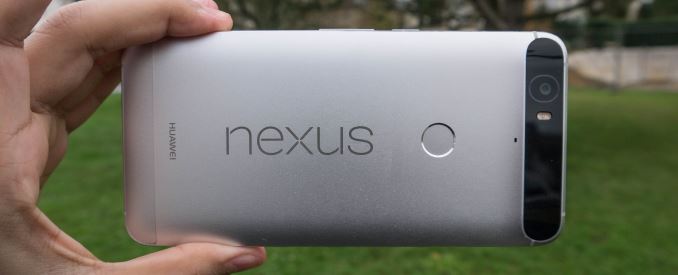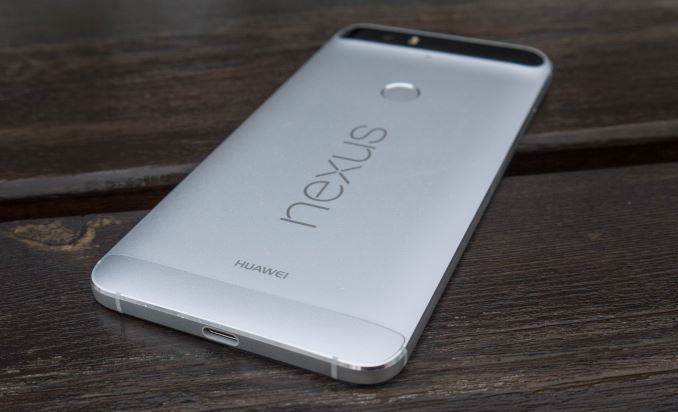The Google Nexus 6P Review
by Andrei Frumusanu on December 16, 2015 8:00 AM ESTFinal Words
As we reach the conclusion of our Nexus 6P review, we’re hopefully left with a more educated view of how the 6P performs and why it perform as it does. It’s also the first showing from Huawei as a Nexus partner, and I think that Huawei has proven itself to be an extremely competent partner at that.
Design-wise, the Nexus 6P takes advantages of Huawei’s experience in building aluminium uni-body phones which results in an extremely solidly built device. While the front face of the phone doesn’t have too much character to it due it being little more than an all-black glass surface with screen and the two speaker grills, it’s the back that makes the Nexus 6P to be instantly recognizable. The “visor” as people have come to call it serves both as an aesthetic feature as well as a practical one as it houses the camera system and flash.
The metal finish and polish makes for a solid grip that is helped by the comparatively flatter sides of the device. Here the 6P trades in a bit of in-hand feel for better handling of the large form-factor. And make no mistake as the Nexus 6P is very much a large form-factor phablet device. The 5.7” screen compares to competing devices such as the Note 5 or the Mi Note Pro, however the 6P is noticeably larger than its cousins due to larger bezels both on the sides and especially on the top and bottom.
The large screen is backed by an excellent AMOLED panel from Samsung. Here Google seems to have made a much better choice in panels than what we saw in last year’s Nexus 6 or what Huawei seems to have employed in their own Mate S. Picture quality is comparable to the Note 5, although the 6P loses out in terms of efficiency, only able to slightly beat the Note 4’s screen efficiency.
Performance wise, the Nexus 6P is excellent. Huawei’s internal design and handling of the SoC’s thermal dissipation makes this the best implementation of Qualcomm’s Snapdragon 810 SoC. CPU performance is currently among one of the best, particularly in bursty workloads, although it can’t really match the sustained and consistent performance of Samsung’s Exynos 7420 devices or even last year’s Snapdragon 801/805 phones. Gaming performs well too, although we again see that sustained performance is only about half of peak performance, an issue competing high-end Android devices also have to deal with.
Battery life, while being subjectively is very good to the point that no user would have to complain about it, it still falls behind the competition. I’ll be honest and say that 2015 has been a pretty bad year for Android devices, as other than Samsung, vendors had to rely on the Snapdragon 810/808’s rather disappointing power efficiency. It’s the fact that you know that a device could have done much better had it had a different SoC that simply leaves me hesitant in praising the Nexus 6P’s battery life. It reminds me of Huawei’s own Mate 7, which while it had excellent battery life due to the very large battery capacity, it failed to be able to provide results worthy able to live up to the specifications.
Meanwhile the camera on the Nexus 6P is among the best, although there were some software processing and consistency issues discovered. Due to these issues encountered in my testing I’m a bit undecided on how to evaluate the 6P’s camera. In situations where it manages to perform, it performs excellently. But as we’ve seen there’s also scenarios where it struggles to get good exposure, and I view that as more important than having an edge in sharpness and effective spacial resolution. And an edge in sharpness is something the Nexus 6P very much has. While the Nexus 6P’s daylight performance can be argued about, it absolutely seems to lead in low-light scenarios as the camera sensor is able to resolve that much more details than the competition; as long as it exposes and color-balances correctly (most of the time).
Wrapping things up, we’re left with the question of the Nexus 6P is a worthwhile buy or not. Here I’d like to offer two conclusions, one for US users and one for buyers in Europe and the rest of the world. At a US price starting at $499 for an unlocked variant, it seems that the Nexus 6P hits a sweet-spot in terms of price-performance and is able to position itself very competitively against other devices. Google’s own services are also much more prevalent and far reaching in North America, so there’s definitely advantage of having a pure Nexus experience (Along with the non-carrier firmware advantage). Here the Nexus 6P is definitely a worthwhile purchase.
For regions outside of North America, and Europe especially, the Nexus 6P just seems an unreasonable device. Starting at prices from 649€, you would expect a device without drawbacks, and it’s simply not worth the premium over other devices, or at the same price you’ll be better off with an equally priced S6 Edge+ or Note 5 if it’s available in your region. Here, the Nexus 6P just simply doesn’t seem that attractive unless you’re putting a lot of weight into the Google Nexus experience, which I find to be a rather subjective aspect of the device. With Snapdragon 820 phones coming in just a few months there’s also the viable option to hold out for better alternatives as we're on the verge of a large generational jump that will undoubtedly bring a lot of improvements to the table.












219 Comments
View All Comments
Speedfriend - Thursday, December 17, 2015 - link
"iOS's main "back" action is a simple right-swipe from left edge, which is the best implementation of all."It is crap. It doesn't work in all apps. The one app where I need it most (a trading app when the charting hangs) it simply doesn't work and which is why I have an Android phone as well
star-affinity - Sunday, December 20, 2015 - link
I think that's pretty much the fault of the developer of that app, and mot the functionality of the feature.star-affinity - Sunday, December 20, 2015 - link
Not* (not "mot").theduckofdeath - Monday, December 21, 2015 - link
If it's a poorly implemented system feature it's surely a fault on Apple's side.tipoo - Tuesday, December 22, 2015 - link
It's inconsistent within iOS itself though. Go through a few settings pages and you'll find some support back swipe, some don't.Jason Dick - Thursday, December 17, 2015 - link
This has long been a complaint with Android, but I haven't had any issues with Google Now or Location services on my Nexus 6p. The new "deep sleep" mode with Marshmallow seems to prevent these from causing problems. I ran a little test for myself last week to see if I could go a full 48 hours without recharging the device. I used the phone for some light web browsing and navigation to/from work (total driving time ~1 hour).Using these services really shouldn't be a problem any longer.
eric3448 - Wednesday, June 15, 2016 - link
I just don't know what the problem is.Surely its easy to just download an app if you want something the phone hasn't gotACE76 - Wednesday, December 16, 2015 - link
It's so sad to see Anandtech fall so far from grace since Mr. Shimpi jumped ship for Apple...I still don't understand why Anandtech doesn't at the vbery least point out the architectural differences when comparing smartphones....Android was built to be a true multi-tasking OS...Apple was not...anyone who knows hardware knows single threaded architectures will score higher...honestly, apple's A9 SOCs are nowhere near as powerful as Qualcom's 810 and newer SOCs...maybe if someone could get iOS to run on a Snapdragon SOC, we'd see the truth...kind of like when apple first jumped to Intel CPUs and saw increases of over 600% in performance.tuxRoller - Thursday, December 17, 2015 - link
While I've issues with this review (mostly tone related) I can't say that I've noticed a drop in quality from AT.Also, both ios and Android are "multitasking" but Android gives developers a bit more rope than ios does... sometimes to the detriment of the app.
The A9 is simply the best soc for a phone around. No serious person is questioning this.
Ethos Evoss - Sunday, December 20, 2015 - link
@tuxRoit is best but in draining battery in half day.. they didn't set any power saving modes so their soc ALWAYS runs at max. performance so that is why everybody thinks is best .. but it is all useless,everybody wants lasting long battery life